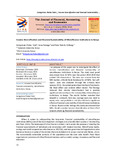| dc.contributor.author | Talel, Livingstone Cheboi | |
| dc.contributor.author | Asienga, Irene | |
| dc.contributor.author | Githaiga, Peter Nderitu | |
| dc.date.accessioned | 2025-03-14T08:48:10Z | |
| dc.date.available | 2025-03-14T08:48:10Z | |
| dc.date.issued | 2024-01-08 | |
| dc.identifier.uri | https://doi.org/10.58857/JFAE.2024.v01.i01.p04 | |
| dc.identifier.uri | http://ir.kabarak.ac.ke/handle/123456789/1694 | |
| dc.description.abstract | The purpose of this paper was to investigate the effect of
income diversification and financial sustainability of
microfinance institutions in Kenya. The study used panel
data drawn from 32 MFIs over the period 2010-2019 that
yielded 320 observations. The data was sourced from the
MIX market, a World Bank Database for all MFIs that selfreport. Data was analyzed through the ordinary least
squares (OLS), the system generalized method of moments,
the fixed effect and random effect model. The findings
revealed that income diversification had a positive
significant relationship to the sustainability of microfinance
institutions in Kenya. The results further revealed that
breadth of outreach, firm size, average loan size, debt to
equity ratio and portfolio at risk (Par>30) had a significant
effect on financial sustainability of microfinance institutions
in Kenya. Based on the findings this study recommend that
MFIs should consider income diversification in their effort
towards attaining financial sustainability. | en_US |
| dc.language.iso | en | en_US |
| dc.subject | Kenya | en_US |
| dc.subject | Microfinance institutions | en_US |
| dc.subject | financial sustainability | en_US |
| dc.subject | Income diversification | en_US |
| dc.title | Income Diversification and Financial Sustainability of Microfinance Institutions In Kenya | en_US |
| dc.type | Article | en_US |

